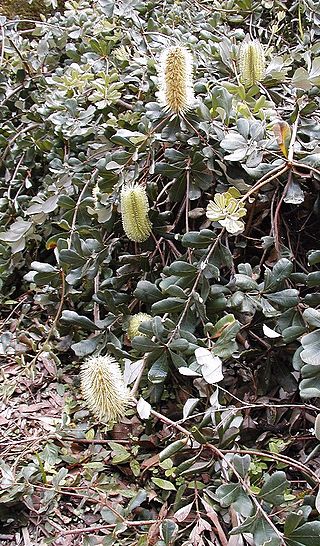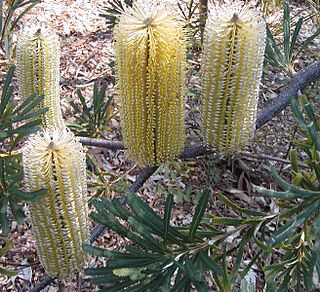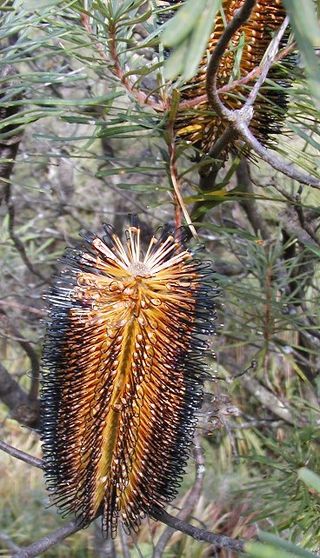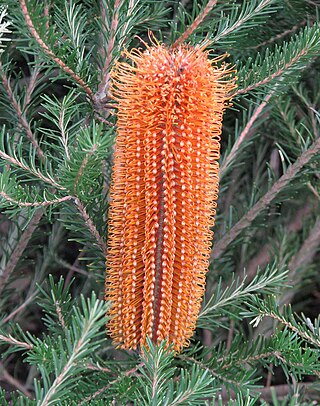
Banksia is a genus of around 170 species of flowering plants in the family Proteaceae. These Australian wildflowers and popular garden plants are easily recognised by their characteristic flower spikes, and woody fruiting "cones" and heads. Banksias range in size from prostrate woody shrubs to trees up to 30 metres (100 ft) tall. They are found in a wide variety of landscapes: sclerophyll forest, (occasionally) rainforest, shrubland, and some more arid landscapes, though not in Australia's deserts.

Banksia integrifolia, commonly known as the coast banksia, is a species of tree that grows along the east coast of Australia. One of the most widely distributed Banksia species, it occurs between Victoria and Central Queensland in a broad range of habitats, from coastal dunes to mountains. It is highly variable in form, but is most often encountered as a tree up to 25 metres (82 ft) in height. Its leaves have dark green upper surfaces and white undersides, a contrast that can be striking on windy days.

Banksia serrata, commonly known as the saw banksia, the old man banksia, the saw-tooth banksia or the red honeysuckle and as wiriyagan by the Cadigal people, is a species of woody shrub or tree of the genus Banksia, in the family Proteaceae. Native to the east coast of Australia, it is found from Queensland to Victoria with outlying populations on Tasmania and Flinders Island. Commonly growing as a gnarled tree up to 16 m (50 ft) in height, it can be much smaller in more exposed areas. This Banksia species has wrinkled grey bark, shiny dark green serrated leaves and large yellow or greyish-yellow flower spikes appearing over summer. The flower spikes, or inflorescences, turn grey as they age and pollinated flowers develop into large, grey, woody seed pods called follicles.

Banksia ericifolia, the heath-leaved banksia, or lantern banksia, is a species of woody shrub of the family Proteaceae native to Australia. It grows in two separate regions of Central and Northern New South Wales east of the Great Dividing Range. Well known for its orange or red autumn inflorescences, which contrast with its green fine-leaved heath-like foliage, it is a medium to large shrub that can reach 6 m (20 ft) high and wide, though is usually half that size. In exposed heathlands and coastal areas, it is more often 1–2 m (3.3–6.6 ft).

Banksia spinulosa, the hairpin banksia, is a species of woody shrub, of the genus Banksia in the family Proteaceae, native to eastern Australia. Widely distributed, it is found as an understorey plant in open dry forest or heathland from Victoria to northern Queensland, generally on sandstone though sometimes also clay soils. It generally grows as a small shrub to 2 metres (7 ft) in height, though can be a straggly tree to 6 metres (20 ft). It has long narrow leaves with inflorescences which can vary considerably in coloration; while the spikes are gold or less commonly yellowish, the emergent styles may be a wide range of colours – from black, purple, red, orange or yellow.

Banksia'Giant Candles' is a registered Banksia cultivar. It is a hybrid between the Gosford form of B. ericifolia and a form of B. spinulosa var. cunninghamii.

Banksia canei, commonly known as the mountain banksia, is a species of shrub that is endemic to southeastern Australia. It is generally encountered as a many-branched shrub that grows up to 3 m (10 ft) high, with narrow leaves and the yellow inflorescences appearing from late summer to early winter. The old flowers fall off the spikes and up to 150 finely furred follicles develop, which remain closed until burnt in a bushfire. Each follicle bears two winged seeds. Response to fire is poorly known, although it is thought to regenerate by seed. Birds such as the yellow-tufted honeyeater and various insects forage among the flower spikes. It is frost tolerant in cultivation, but copes less well with aridity or humidity and is often short-lived in gardens. One cultivar, Banksia 'Celia Rosser', was registered in 1978, but has subsequently vanished.

Banksia marginata, commonly known as the silver banksia, is a species of tree or woody shrub in the plant genus Banksia found throughout much of southeastern Australia. It ranges from the Eyre Peninsula in South Australia to north of Armidale, New South Wales, and across Tasmania and the islands of Bass Strait. It grows in various habitats, including Eucalyptus forest, scrub, heathland and moorland. Banksia marginata varies widely in habit, ranging from a 20-centimetre (7.9 in) shrub to a 12-metre (40 ft) tree. The narrow leaves are linear and the yellow inflorescences occur from late summer to early winter. The flower spikes fade to brown and then grey and develop woody follicles bearing the winged seeds. Originally described by Antonio José Cavanilles in 1800, further collections of B. marginata were designated as several separate species by Robert Brown in 1810. However, all were reclassified as a single species by George Bentham in 1870. No distinct subspecies have been recognised by Banksia expert Alex George, who nonetheless concedes that further work is needed.

Banksia paludosa, commonly known as the marsh or swamp banksia, is a species of shrub in the plant genus Banksia. It is native to New South Wales, Australia, where it is found between Sydney and Batemans Bay, with an isolated population further south around Eden. There are two recognised subspecies, the nominate of which is a spreading shrub to 1.5 m (4.9 ft) in height, and subsp. astrolux is a taller shrub to 5 m (16 ft) high found only in Nattai National Park.

Banksia 'Roller Coaster', sometimes referred to as Banksia 'Austraflora Roller Coaster', is a registered Banksia cultivar bred from Banksia integrifolia subsp. integrifolia. Its extended cultivar name is Banksia integrifolia 'Roller Coaster'. It was bred, propagated and promoted by horticulturist Bill Molyneux of Austraflora nursery in Victoria, Australia. Chosen and bred for its vigorous prostrate habit, this has become a popular plant in both private and public gardens in eastern Australia, particularly Sydney and Melbourne.

Banksia 'Lemon Glow', also known by its extended cultivar name Banksia spinulosa var. cunninghamii 'Lemon Glow', is a form of Banksia spinulosa var. cunninghamii with lemon-yellow flowers. It was selected by Alf Salkin from a wild population on French Island, Victoria, and registered as a cultivar on 5 October 1982. It typically grows 2–3 m tall by 2 m wide. It flowers from April to May.
Banksia 'Limelight', also known by its extended cultivar name Banksia ericifolia 'Limelight', is a registered cultivar of Banksia ericifolia. It has bright lime-green foliage, otherwise appearing typical of B. ericifolia. It grows at about half the rate of B. ericifolia, and can only be propagated vegetatively.

Banksia 'Pygmy Possum', formerly Banksia 'Austraflora Pygmy Possum', and also known by its extended cultivar name Banksia serrata 'Pygmy Possum', is a registered Banksia cultivar. It is a sprawling, very low growing coastal form of Banksia serrata, with very small leaves and small inflorescences.

Banksia'Stumpy Gold' is a dwarf cultivar of Banksia spinulosavar. collina that was selected by Richard Anderson of Merricks Nursery in Victoria from material collected at Catherine Hill Bay on the New South Wales Central Coast. It is a stunted shrub growing to 50 cm tall and wide and has all gold inflorescences which appear in autumn. Its foliage is noticeably greyer than the similarly sized and much better known and more widely grown Banksia 'Birthday Candles', which has reddish-styled golden blooms rather than all gold.

Banksia spinulosa var. collina is a shrub that grows along the east coast of Australia, in Queensland and New South Wales. Commonly known as Hill Banksia or Golden Candlesticks, it is a taxonomic variety of B. spinulosa. It is a popular garden plant widely sold in nurseries.

Banksia spinulosa var. spinulosa is a shrub that grows along the east coast of Australia, in Queensland and New South Wales.

Banksia neoanglica, commonly known as New England banksia is a shrub or small tree with leaves that are greenish on the upper surface, whitish with soft hairs on the lower side and spikes of flowers with styles that turn black as they open. It is similar to Banksia spinulosa and was formerly known as Banksia spinulosa var. neoanglica, but differs in that its leaves are wider and have margins that are not tightly turned under. It is found mainly along the eastern edge of the Great Dividing Range.

Banksia spinulosa var. cunninghamii, sometimes given species rank as Banksia cunninghamii, is a shrub that grows along the east coast of Australia, in Victoria and New South Wales. It is a fast-growing non-lignotuberous shrub or small tree infrequently cultivated.

Banksia 'Yellow Wing' is a Banksia cultivar developed by Austraflora Nurseries of Dixons Creek in Victoria, Australia.
Banksia vincentia is a shrub that grows in a small location in southern New South Wales. It belongs to the Banksia spinulosa species complex and has affinities to Banksia neoanglica, found several hundred kilometres to the north.


















